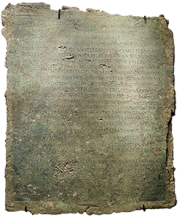
Séance du séminaire Épigraphie grecque et latine
Présentation par Florian Matei-Popescu (Vasile Pârvan Institute of Archaeology, Bucharest)
- 5 décembre 2023 - de 17h à 19h - salle Reinach - MOM - entrée par l'Université de Lyon2 - 86 rue Pasteur - Lyon 7e
- lien de connexion ZOOM ( ID Réunion : 955 6428 0136 / code : hAT13N)
- programme 2023-2024
The volume VI.4-5 of the Inscriptiones Scythiae minoris Graecae et Latinae (ISM) will gather the inscriptions from the Romanian section of the Lower Danubian frontier, the area covered by the volumes IV and V of the ISM series. The fifth volume appeared in 1980 (Emilia Doruțiu-Boilă), more than fourty years ago, while the fourth, published in 2015, was conceived back in the 1970s by Emilian Popescu. Newly published inscriptions were integrated, of course, but the style and concept were already obsolete at the moment of publication. The new volume will follow the same pattern as ISM VI.2, published by Alexandru Avram, Maria Bărbulescu, and Livia Buzoianu in 2018, with a first part of addenda et corrigenda and a second one presenting the inscriptions found after 1980 or 2014.
Many of the inscriptions were discovered during the archaeological excavations carrying out almost every season in the Roman sites along the Danube, such as Durostorum, Capidava, Troesmis, Noviodunum or Halmyris, and in the hinterland, such as Traianum Tropaeum, Slava Rusă, or Ulmetum. Taking into account their context, most of them regard the military milieu of this remote frontier area of the empire, the civil settlements around, and the provincial life in general. The newly discovered military diplomas in hinterland sites, such as Cataloi, Slava Rusă, and Mihai Bravu, shed interesting lights on the settlement of the former members of the auxiliary units, already before the Dacian war.
By far, the most important epigraphic discovery from the past years was that of the two bronze tables which preserve some chapters of the municipal law of the municipium Aurelium Troesmense, which were issued during the joint reign of Marcus Aurelius and Commodus, and which were published in several places by Werner Eck. It is undoubtedly a major witness to the municipal developments within the empire during the second century AD, especially for municipia civium Romanorum, and not for Latin communities, as it was the case of the laws from Baetica, all dating back to the Flavian period. The seminar will provide an opportunity to put this important document into a larger local and regional context, which will take profit of the other epigraphic discoveries from Troesmis, but also from Durostorum, Noviodunum, and Halmyris, in order to draw an image of the municipalisation policy in Moesia inferior in the later years of Marcus Aurelius’ reign.